THE GLOW-WORM'S LIFE-CYCLE
LIFECYCLE GLOSSARY HELPING GLOW-WORMS WHERE TO FIND THEM MY STUDY
THEIR HISTORY MY SURVEY LINKS TO OTHER SITES ABOUT ME MISCELLANY SNAILS
The glow-worm leads a fascinating life, which usually takes them nearly two years to complete. There are several stages in the life-cycle of the glow-worm. They are listed below, click on the thumbnail to find out more about that stage. Many thanks to John Tyler, for letting me use his photographs on this page. You will find them in his book, "The Glow-worm", which tells you just about all the information that we know about British glow-worms!
Egg Larva Pupa Male Female
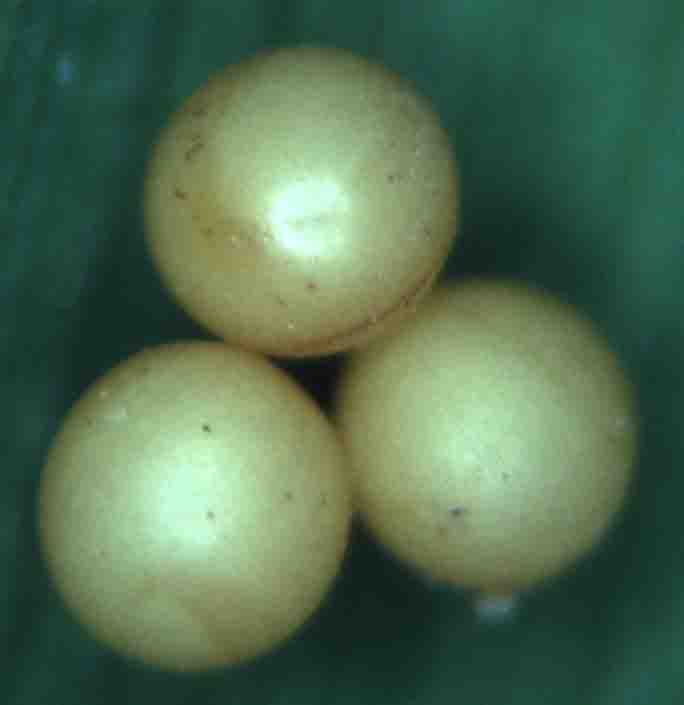
The eggs are laid during the summer months, between mid-June and September. Sometimes eggs glow soon after they have been laid. They dry out easily, and so the female lays them in a cool, damp place such as under stones, branches, logs or in a hole underground - maybe in the burrow of a mouse, mole or solitary bee. The eggs hatch after about 30 days, sometimes upto 45 days if the weather is cold.
Photo: John Tyler
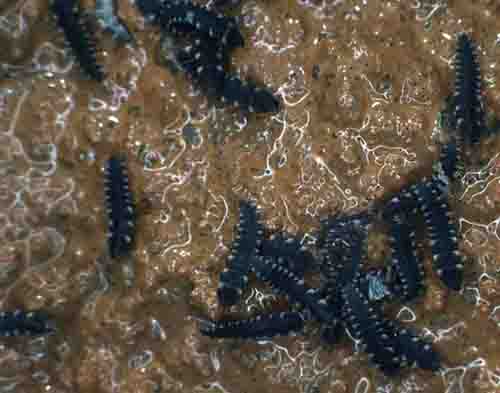
The egg hatches into a tiny larva (plural, larvae). This little creature has one purpose in life - to eat! These have only just hatched. Sometimes they stay in small groups, and sometimes they seem to live alone.
Photo: John Tyler
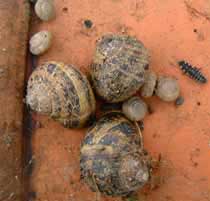 The larva will
hibernate twice; it's 24 month lifespan being spread over three calendar years. This photo is of a
larva that I found hibernating on the underside of a large piece of clay flower
pot in my garden. Under and around the pot were a large number of
empty shells of tiny and large garden snails. The larva, and probably
some of his friends had been feasting before winter! Larvae will sometimes
gang up on larger snails. This larva will have plenty to eat when it wakes
up!
The larva will
hibernate twice; it's 24 month lifespan being spread over three calendar years. This photo is of a
larva that I found hibernating on the underside of a large piece of clay flower
pot in my garden. Under and around the pot were a large number of
empty shells of tiny and large garden snails. The larva, and probably
some of his friends had been feasting before winter! Larvae will sometimes
gang up on larger snails. This larva will have plenty to eat when it wakes
up!
Photo: Simon Frogley
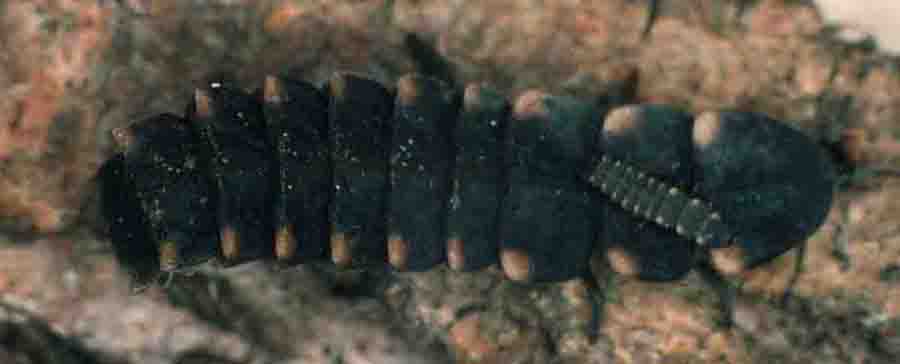
This photograph shows how much the larvae grow. Most of their growing is done in the last three months after hibernating.
Photo's above and below: John Tyler
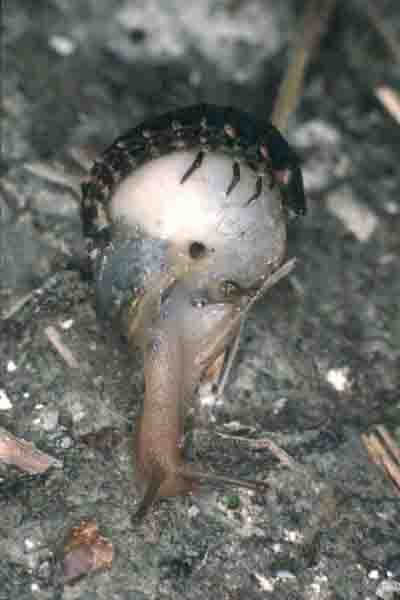 This
larva is killing the snail. It rides on the snail's shell, and injects
digestive enzymes into the back of its neck. The digested flesh is then
sucked up by the glow-worm. Large snails may need several bites before
they die. Snails eaten by glow-worms do not have damaged shells. We
don't know how a larva finds a snail, it seems as if they might just stumble
across them, as they often miss them when fed in captivity. I have often
noticed a large number of empty shells in quite a small area, often where there
is a lot of loose chalk on the surface of the soil to attract the snails.
Maybe the larvae find a good spot, and wait patiently for snails to come
foolishly to them!.
This
larva is killing the snail. It rides on the snail's shell, and injects
digestive enzymes into the back of its neck. The digested flesh is then
sucked up by the glow-worm. Large snails may need several bites before
they die. Snails eaten by glow-worms do not have damaged shells. We
don't know how a larva finds a snail, it seems as if they might just stumble
across them, as they often miss them when fed in captivity. I have often
noticed a large number of empty shells in quite a small area, often where there
is a lot of loose chalk on the surface of the soil to attract the snails.
Maybe the larvae find a good spot, and wait patiently for snails to come
foolishly to them!.
photo: John Tyler
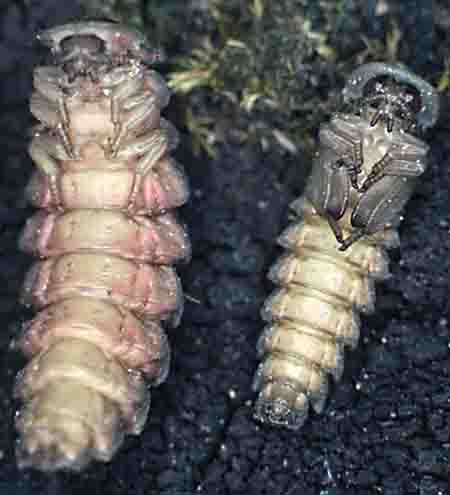 When the larva is fully grown, it turns into a
pupa (or pupates, as we usually say). During this time they turn into the adult form.
The female larva and pupa is much larger than the male, as can be seen in this
photo of John Tyler's. The female takes about 10 days to pupate, and the
male, which has to change much more, takes about 15 days. In this photo'
you can see the wing pouches on the underneath of the male (right). You
can also see that he has bigger eyes than the female - all the better to see her
with!
When the larva is fully grown, it turns into a
pupa (or pupates, as we usually say). During this time they turn into the adult form.
The female larva and pupa is much larger than the male, as can be seen in this
photo of John Tyler's. The female takes about 10 days to pupate, and the
male, which has to change much more, takes about 15 days. In this photo'
you can see the wing pouches on the underneath of the male (right). You
can also see that he has bigger eyes than the female - all the better to see her
with!
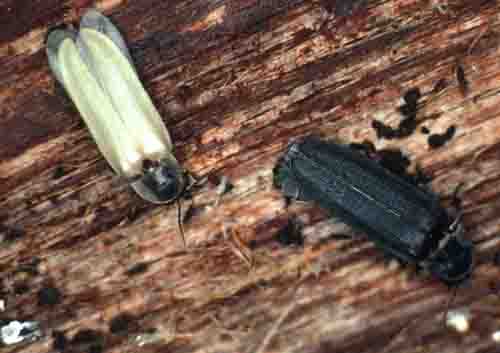 The male glow-worm has wings.
It is almost white when it first emerges as an adult. After about
two hours, as the skin hardens, it goes
black. It usually flies at about one metre above the ground. When it
sees a female, it will drop straight down to her, vertically. We don't
really know if the male mates with more than one female or not.
The male glow-worm has wings.
It is almost white when it first emerges as an adult. After about
two hours, as the skin hardens, it goes
black. It usually flies at about one metre above the ground. When it
sees a female, it will drop straight down to her, vertically. We don't
really know if the male mates with more than one female or not.
 The female adult glow-worm is the
one that we usually see. It uses the chemicals luciferin and luciferase to
make a chemical reaction that produces a cold light. This light can be
turned on and off at will, and is more efficient than any of man's! Like
the male, the adult female has no mouth, and so cannot eat. She therefore
has to be very careful to use as little energy as possible. She will have
a hiding place in a cool spot - probably underground - during the day. At dusk, she will crawl up a stem, so that she is
as high as possible,
and can be spotted easier by a male. If she attracts a male and mates,
then she will return to her hole and lay eggs before dying. If she does
not attract a male after about three hours, then she will go back to her hole
for the day, and try again the next night. It is important for both male
and female to use as little energy as possible as they cannot feed. The
female can only survive for upto about two weeks. If she does not find a
mate, then she will still lay her eggs in a final desperate attempt to save
them, but they will not be fertile, and so won't
hatch. Hopefully, most find a mate within a day or two, and so you are
always seeing different females glowing. If it is wet or windy, then the
females will stay closer to the ground where they have some
shelter.
The female adult glow-worm is the
one that we usually see. It uses the chemicals luciferin and luciferase to
make a chemical reaction that produces a cold light. This light can be
turned on and off at will, and is more efficient than any of man's! Like
the male, the adult female has no mouth, and so cannot eat. She therefore
has to be very careful to use as little energy as possible. She will have
a hiding place in a cool spot - probably underground - during the day. At dusk, she will crawl up a stem, so that she is
as high as possible,
and can be spotted easier by a male. If she attracts a male and mates,
then she will return to her hole and lay eggs before dying. If she does
not attract a male after about three hours, then she will go back to her hole
for the day, and try again the next night. It is important for both male
and female to use as little energy as possible as they cannot feed. The
female can only survive for upto about two weeks. If she does not find a
mate, then she will still lay her eggs in a final desperate attempt to save
them, but they will not be fertile, and so won't
hatch. Hopefully, most find a mate within a day or two, and so you are
always seeing different females glowing. If it is wet or windy, then the
females will stay closer to the ground where they have some
shelter.